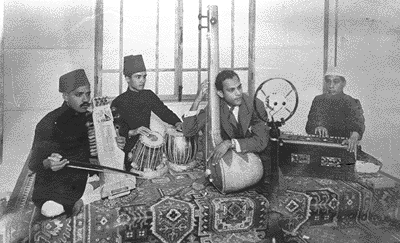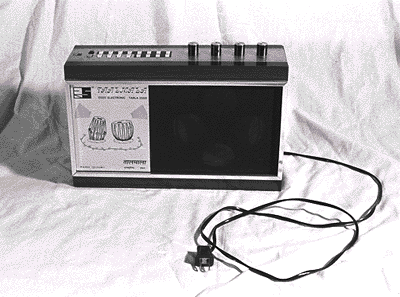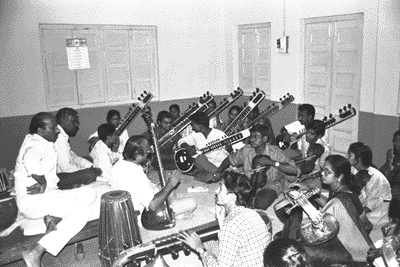| This article originally appeared in “Technological Directions in Music Education” (Conference Proceedings) at the Institute for Music Research, University of Texas at San Antonio, pg. 32-40, 1994 Please note that today the use of various apps in Indian musical education is normal, but this article was published many decades before such apps were available. |
Abstract
Electronic aids to music education have been a major component of the Western pedagogic process for many years. However the application of high technology has only recently begun in India. Today there is an environment which is ripe for the spread of electronics into the field of music and music education. Applications as diverse as desktop publishing, electronically assisted education (audio/video cassettes) radio and TV programs and a host of electronic gadgets have already entered the educational process.
Introduction
Technology has had a tremendous impact on music education in the Western world. However the impact upon Indian music is just now being felt. This paper will provide a brief overview of the history, present situation, and future possible applications of electronic aids in the education of Indian music. A brief introduction to Indian music will place things in perspective and make our discussions easier.
Historical Background
We can appreciate the present situation by having a firm understanding of the development of both Indian music and the Indian electronics industry. We will see that the music of India is an ancient system which is quite different from our own. Furthermore the pedagogic process, which is essentially an apprenticeship, is also quite different from ours. All of this must be seen so that we can appreciate the application of modern technology by India’s indigenous electronics industry.
The musical tradition of India is one of the oldest in the world. However, within this tradition there are numerous subtraditions, and individual styles. Such a variegated musical environment could make a discussion difficult if it were not for one thing. Just as the Western classical tradition is considered the foundation for musical education; in the same way, the classical music of India is considered the foundation for musical education in India. We need not concern ourself with the multiplicity of musical styles. However we must not forget that there are two classical musical systems in India. There is the north Indian tradition, known as Hindustani sangeet; and there is also the south Indian tradition, known as Carnatic sangeet. Fortunately, the theoretical differences do not effect our discussion.
It is difficult to describe the Indian system of music in a few words. The most fundamental point is that it is a modal system based upon pure tones rather than tempered tones. The drone is an essential component of the music. It is this drone which provides the tonic base upon which the modes may be developed. Unlike Western music, the key is of no theoretical importance. Whether a piece is performed in C, B, F or whatever, is purely a matter of convenience. These pieces are performed in highly developed rhythmic cycles known as tal. These tals are generally large structures of 6, 7, 8, 10, 12, 14, or 16 beats. The basic theory of Indian music is covered in greeater detail in other sources (Courtney 1992a).
This highly developed system requires many years of formal training. This is in the form of an apprenticeship. For many millennia the craft has been passed from teacher to disciple in a process known as guru-shishya-parampara (Courtney 1992b). Although this is still considered the traditional mode of education, in practice the student receives a large amount of information through the electronic media. A clear picture of this media can be seen by looking at the rise of high technology in the country.
The development of India’s electronic and technological infrastructure is interesting because it developed largely separate from the world markets. The early days of independence were dominated by the Gandhian concept known as “Swadeshi”. Swadeshi is the political and economic concept of self sufficiency. During the independence movement, self sufficiency in the homespun cotton industry was largely responsible for making the continuance of India in the British empire uneconomical. These economic pressures persuaded Britain to grant autonomy. The concept of self sufficiency acquired a socialistic colour after independence. Nehru was using the Soviet Union as a model for industrial development. This allowed India to develop an indigenous electronics industry which was unconnected to the world markets. Although this industry was never able to come up to world standards, it did create an environment in which indigenous approaches could be developed for purely Indian musical needs. These will be discussed later. Before we look at these devices which are relevant only to Indian music let us first look at the power of traditional analog approaches.
Established analog technologies already have shown profound effect on the system of education. Analog technologies are commonly used in radio, TV, and tape recorders. Until recently the only radio and TV in India were the government owned “Akashavani”, otherwise known as “All India radio” and “Dooradarshan” (TV) (see figure 1). The government has a sustained interest in promoting traditional Indian music. One of the efforts has been occasional broadcasts of educational programs on Indian music.

Figure 1. Early Radio Broadcast (circa 1938)
Some of the most significant effects have been from the “National Programs”. These are performances given by India’s top artists which are aired all over the country. An artist may perform something on national TV and within a week, other musicians around the country are doing similar things. What makes this so important is that it introduces a fundamental change in the way musical information is transferred. Previously the only process for transmission of musical material has been from guru to disciple. This is a vertical flow of information known as “Taleem”. The use of the electronic media creates a horizontal flow of information which cuts across traditional pedagogic lines (see figure 2).

Figure 2. Diagram showing flow of musical material.
Vertical is “Taleem” or the material from the traditional
“Guru-Shishya” relationship. The lateral flow of material
is from the media.
We may summarize the history of electronics and Indian music quite simply. The music of India is an ancient modal form that is fundamentally different from the Occidental system. For thousands of years the musical material traveled along a simple linear path from teacher to disciple. Cross linkages were rare until relatively recently. The major increase in this horizontal flow of musical information began with the advent of the electronic media. The development of an indigenous electronics industry, essentially cut off from the larger world markets, has had interesting effects on musical electronics. We will now discuss this further.
Present Applications
It is appropriate for us to take a closer look at the present situation. We find numerous examples of electronic aids being employed in the pedagogic process. Many of these are well entrenched while many others are experimental.
Shruti Generation – Shruti is the drone which is used in Indian music. This was normally provided by a stringed instrument (tamboura) or a small hand pumped reed instrument (Sur peti) . However, for over twenty years, electronic sur petis have been in use by many students (figure 3). They have recently been refined to the present day “Electronic Tamboura”. In southern India the electronic “Surpeti” or “Shruti Box” has become essential for any music student. It is even used in performances. Although it does not have the same level of popularity in the north, its use is rising fast. These devices are of Indian design and manufacture and have almost no parallel in the electronic instruments of the West.

Figure 3. Electronic “Sur Peti” or “Shruti Box” is used to provide the drone for Indian music.
Lahara Generation – Lahara is a small repeating melody used to accompany drum solos. This function has been traditionally performed by a live musician. However experiments have been going on for some years to replace the human with an electronic equivalent. I have been using computer generated laharas in the pedagogic process since 1988 with very good results (Courtney 1991b).
Theka Generation – This is roughly comparable to the function of a Western drum machine. There are several approaches. The most widespread is a dedicated device called a “Tal Mala” (figure 4). These devices of Indian design and manufacture and give a sound which is comparable to tabla (an Indian drum).

Figure 4. “Tal Mala” is similar to a drum machine which is programmed to give
common north Indian rhythms.
I have spent a considerable time working on another course, specifically computer generated theka. Such an approach is presently cost prohibitive in India. However it has certain advantages over the tal mala. The most striking advantage is the natural sound. This is a consequence of the fact that my experiments have been based upon sampled lahara rather than the synthesized version that is a characteristic of the Indian tal mala.
Data Bases – It is possible to take Indian music, quantify it, and encode it to create data bases of rags and compositions. This is philosophically similar to the musical encoding schemes found in MIDI approaches (Courtney 1991). I have spent a considerable amount of time in this area and have found that a higher resolution is required than found in the MIDI protocols (Courtney 1989). These efforts are described in greater detail elsewhere (Courtney 1990).
Desktop Publishing – The field of desktop publishing is one area where the impact of digital technologies may be found. Although the printed text has been an important part of the educational process for many years, market pressures have made it very risky to publish books on Indian music. This risk is somewhat reduced by advances in desktop publishing which drastically reduce the cost of typesetting.
Computer Analysis – Computers have made it possible to analyze Indian music and Indian musical instruments in a way that was never possible before. Spectrum analysis have made it possible to look closely at the sounds of Indian musical instruments and even at the influence that spectral components have upon the development of scale structure and intonation (Carterette 1989).
Basic Music Theory – Computers have been used on several occasions to clarify aspects of music theory. It has been used in areas of intonation (Rao 1989), musical structure (Srinivasan 1979), and virtually every aspect of music theory.
We have seen that electronic technology has been used to produce a number of educational aids. The most common is the tal mala which generates drum beats and the surpeti which generates the drone. The computer has emerged as a major tool for both research, education, and in desktop publishing. With a clear concept of the present usage, we may speculate as to what future applications may be.
Future Directions
Prognostication is always a risky business. However it is safe to say that the computer will play an increasing role in future applications of electronics to the education of Indian music. Clearly all of the components are there; a large base of computer literate personnel coupled with falling hardware prices. The increased availability of hardware and the large number of computer literate people to operate them cannot help but find applications in every field of life, including music.
One possible application is in the area of computer assisted education. Presently public schools may have no music teacher and private schools may have one for several hundred students. Clearly the shortage of teachers could be alleviated with computer assisted education. Even the music colleges (figure 5) which do not have a shortage of teachers could benefit from computer assisted education. Although such an approach clearly is contrary to traditional educational concepts, India has shown a tremendous ability to accommodate new technologies and educational practices (Courtney 1992b).

Figure 5. The music colleges are places which could benefit from computer assisted education
Another area of possible development is in the area of musicological research. If a standard musical coding scheme can be worked out it opens the possibility of expanding the data bases and using them to investigate various aspects of musical performance and theory.
There are other aspects which would be considered science fiction if it were not for there immediate possibility. For example let us consider the possibility of recreating a musical genius of the past. It is theoretically possible to go back an examine a large body of recordings and create a knowledge base derived from that material. Once the appropriate artificial intelligence structures have been created it should then be possible to feed a new rag into the machine. The computer could then compose a piece in the same style as the deceased musician; even for rags which did not exist during the lifetime of the musician.
Conclusion
India is already making significant use of electronics in the process of music education. generation of drones, and rhythms are a commonplace, with experimental efforts at lahara (repetitive melodies), data bases. Computer assisted composition and computer assisted education cannot be far off. However we are only looking at a small number of educational possibilities, many are yet to be thought of. Although India has a tremendous respect for tradition, this respect has never hindered the acceptance of new technologies. Therefore it is highly unlikely that the traditional guru-shishya system will disappear, but it should continue with the new tools of the 21st century.
Works Cited
Courtney, David R.
1989 “An Indian Music Specific Audio Driver”, Journal of the Acoustical Society of India, Calcutta: Vol. 17, No 3&4, December, pp. 269-272.
1990 A Low Cost System for the Computerization of North Indian Classical Music (Dissertation) IIAS, University Microfilms International, Ann Arbor: March 1990: pp. 200: Order Number LD01730.
1991a “MIDI Protocol”, Syntax, CHUG Inc., Tomball: Dec./Jan 1991: pp. 14-19.1991b “The Application of the C=64 to Indian Music: A Review”, Syntax , Houston: June/July 1991: pp 8-9.
1992a Elementary North Indian Vocal. Sur Sangeet Services, Houston: pp.151.
1992b New Approaches to Tabla Instruction. Percussive Notes. Vol 30 No 4: Lawton OK: Percussive arts Society.
Srinivasan, R.
1979 “Computer Approach to the Anaylysis of Musical Scales, Shrutis and Murcchanas”, Mathematical and Computer Anaylsis of Raga Structure, Srutis and Murcchanas, Proceedings of the Seminar on Musicology. Feb 26-28. University of Madras:123-141
Rao, S.S., Nawathe, S.P., Bhave, S.S., Atre, Prabha
1989 “A Study of Intonation in Hindustani Classical Music”, Journal of the Acoustical Society of India, Calcutta: Vol. 17, No 3&4, December, pp. 273-276.
Carterette, Edward; Vaughn, Kathryn; Jairazbhoy, Nazir A.
1989 “Perceptual, Acoustical, and Musical Aspects of the Tamboura drone”. Music Perception. Winter 1989, Vol 7, No 2, 75-100, University of California.
